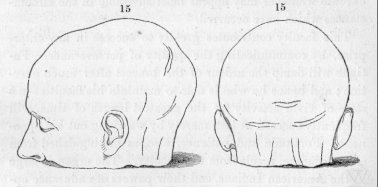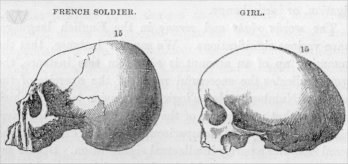George Combe's A System of Phrenology, 5th edn, 2 vols. 1853.
Vol. 1: [front
matter], Intro, Nervous
system, Principles of Phrenology, Anatomy of the brain, Division of the faculties 1.Amativeness 2.Philoprogenitiveness 3.Concentrativeness 4.Adhesiveness 5.Combativeness 6.Destructiveness, Alimentiveness, Love of Life 7.Secretiveness 8.Acquisitiveness 9.Constructiveness 10.Self-Esteem 11.Love
of Approbation 12.Cautiousness 13.Benevolence 14.Veneration 15.Firmness 16.Conscientiousness 17.Hope 18.Wonder 19.Ideality 20.Wit or Mirthfulness 21.Imitation.
Vol. 2: [front
matter], external senses, 22.Individuality 23.Form 24.Size 25.Weight 26.Colouring 27.Locality 28.Number 29.Order 30.Eventuality 31.Time 32.Tune 33.Language 34.Comparison, General
observations on the Perceptive Faculties, 35.Causality, Modes of actions of the faculties, National
character & development of brain, On the
importance of including development of brain as an element in statistical
inquiries, Into the manifestations of the animal,
moral, and intellectual faculties of man, Statistics
of Insanity, Statistics of Crime, Comparative
phrenology, Mesmeric phrenology, Objections
to phrenology considered, Materialism, Effects
of injuries of the brain, Conclusion, Appendices: No. I, II, III, IV, V,
[Index], [Works of Combe].
15.--FIRMNESS.
THIS organ is situated at the posterior part of the coronal region of the head, close upon the middle line.
Dr Gall observed, that persons of a firm and constant character have this part of the brain much developed ; and Lavater had previously remarked the same configuration in individuals of that disposition. It is difficult to determine, by analysis, the ultimate principle of this faculty. Dr Gall remarks, that, properly speaking, Firmness is neither an inclination nor a power ; " c'est une manière d'être qui donne à t homme une empreinte particulière que Von appelle le caractère ; he who is deficient in it," says he, " is the sport of external circumstances, and of communicated impressions." Its effects, says Dr Spurzheim, are mistaken for will; because those in whom it is large are prone to use the phrase "I will,'" with great emphasis, which is the natural language of deter-
414 FIRMNESS.
mination ; but this feeling is different from proper volition. It gives fortitude, constancy, perseverance, determination ; and, when too energetic, produces obstinacy, stubbornness, and infatuation. Its organ will be found large in stubborn and untractable children.
Firmness seems to be a faculty which has no relation to external objects : its influence terminates in the mind itself, and adds only a quality to the manifestations of the other powers ; thus, acting along with Combativeness, it produces determined bravery ; with Veneration, sustained devotion ; and with Conscientiousness inflexible integrity. It gives, however, perseverance in manifesting only such of the other faculties as are possessed in an available degree. An individual having much Firmness and considerable Tune, may persevere in making music ; if Tune were greatly deficient, he would not be disposed to persevere in that attempt ; but if he possessed much Causality, he might persevere in abstract study. At the same time Dr Gall justly remarks, that firmness of character ought not to be confounded with perseverance in gratifying the predominating dispositions of the mind. Thus an individual, in whom Acquisitiveness is the strongest propensity, may, although Firmness be deficient, exhibit unceasing efforts to become rich, but he will be vacillating and unsteady in the means which he will employ ; he will to-day be captivated by one project, to-morrow by an another, and the next day by a third ;-whereas, with Firmness large, he would adopt the plan which appeared to him most promising, and steadily pursue it to the end. We may persevere in a course of action from two motives-either, first, because it is of itself agreeable, or, secondly, because we have resolved so to act. It is Firmness which gives origin to the latter motive, and enables us to persist with vigour in conduct once decided upon whether agreeable or the reverse.
When this organ predominates, it gives a peculiar hardness to the manner, a stiffness and uprightness to the gait, with a forcible and emphatic tone to the voice.
FIRMNESS. 415
A due degree of it is essential to the attainment of eminence in any difficult pursuit. Dr Gall observes, that, when it is large, the motto of the individual will be, " Tu ne cede malls, sed contra audacior ito." It produces the " (enaxpro-positi vir." The organ is larger in the British than in the French, and the latter are astonished at the determined perseverance of the former, in the prosecution of their designs, whether these relate to the arts, sciences, or war. Napoleon knew well the weakness of the French character in this point, and in his conversations recorded by Count Las Cases, frequently complained of it. In war, the effects of this organ are very conspicuous in the conduct of the two nations. The French, under the influence of large Combativeness, and moderate Cautiousness, make the most lively and spirited attacks, shouting and cheering as they advance to the charge : but, if steadily resisted, their ardour abates ; and, from deficiency in Firmness, they yield readily to adversity. The British, on the other hand, advance to the assault with cool determination, arising from great Firmness, and considerable Cautiousness and Secretiveness ; and, although repulsed, they are not discomfited, but preserve presence of mind to execute whatever may appear most advisable in the circumstances which have occurred.
This faculty contributes greatly to success in any enterprise, by communicating the quality of perseverance. Fatigue will damp the ardour of the bravest after much exertion ; and hence he who is able to maintain his faculties in a state of vivid activity for the greatest length of time, will frequently succeed at last, merely by wearying out his opponent. Fortitude and patience, also, as distinguished from active courage, result from this faculty. The organ is large in the American Indians, and their powers of endurance appear almost incredible to Europeans.1 Dr Gall found it very large in a highwayman, who was exceedingly hardened in crime. He was kept in close confinement for a considerable
1 See Phrenological Journal, ii. 535.
416 FIRMNESS.
time, with the view of forcing him to disclose his accomplices ; but this had no effect, and he was then put to the torture by beating. Finding this infliction intolerable, he strangled himself with his chain. After his death, the parietal bones were found separated precisely at the point were the organ of Firmness is situated. Dr Gall could not determine whether the separation arose from the violent strangulation, from the excessive energy of the organ, or from accident ; but records the fact, to call attention to similar cases, should they occur in future. This organ, and that of Destructive-ness, are very large in John Thurtell, executed for the murder of Weare, and he manifested both powerfully in his conduct. The organ is very large in King Robert Brace, and he was distinguished for unshaken firmness, in circumstances in which an ordinary mind would have been overwhelmed by despair. It is large in Haggart, who also manifested a remarkable degree of determination in crime, and constancy in suffering. The subjoined cuts represent a cast of the head of a gentleman in whom the faculty is very strong, and whose character is described in The Phrenological Journal, vol. viii. p. 206.
15

When the organ is small, the individual is prone to yield to the impulses of his predominating feelings. When Benevolence assumes the sway, he is all kindness ; when Combativeness and Destructiveness are excited, he is passionate,
5
FIRMNESS. 417
outrageous, and violent : and thus he will afford a spectacle of habitual vacillation and inconsistency. If Love of Approbation and Benevolence are large, and Firmness small, solicitation will with great difficulty be resisted. The organ is very small in the cast of Mrs H., and she manifested much unsteadiness of purpose.
This organ is large in Rammohun Roy, p. 45, and in Dr Spurzheim, p. 57; also in Oberlin, Ramus, Stubbs, and Schlabrendorf, of whose heads representations are given in Dr Spurzheim's Phrenology in Connexion with the Study of Physiognomy, pi. xvii. fig. 2 ; xxv. 2 ; and xxvi. 1 and 2. Professor Broussais' remarks on the organ will be found in The Phrenological Journal, vol. x. p. 548. The following cuts shew the appearance of the skull when it is very large and very small.

I am not aware that the metaphysicians admit any faculty corresponding to this sentiment. Resolution is the name given to the emotion which accompanies its active state. It exercises a great influence in forming the character, and its omission is very important in any system of mental philosophy.
The effects of disease of the organ seem to have been little observed. We may infer, that they will be the exaltation of the function-namely, extreme stubbornness and infatuation. One case in which the-organ was very large, and apparently at the same time diseased, is reported by Professor
Dd
418 CONSCIENTIOUSNESS.
Otto of Copenhagen, in The Phrenological Journal, vol. viii p. 66.
The organ is regarded as established.
Vol. 1: [front
matter], Intro, Nervous
system, Principles of Phrenology, Anatomy of the brain 1.Amativeness 2.Philoprogenitiveness 3.Concentrativeness 4.Adhesiveness 5.Combativeness 6.Destructiveness, Alimentiveness, Love of Life 7.Secretiveness 8.Acquisitiveness 9.Constructiveness 10.Self-Esteem 11.Love
of Approbation 12.Cautiousness 13.Benevolence 14.Veneration 15.Firmness 16.Conscientiousness 17.Hope 18.Wonder 19.Ideality 20.Wit or Mirthfulness 21.Imitation.
Vol. 2: [front
matter], external senses, 22.Individuality 23.Form 24.Size 25.Weight 26.Colouring 27.Locality 28.Number 29.Order 30.Eventuality 31.Time 32.Tune 33.Language 34.Comparison, General
observations on the Perceptive Faculties, 35.Causality, Modes of actions of the faculties, National
character & development of brain, On the
importance of including development of brain as an element in statistical
inquiries, Into the manifestations of the animal,
moral, and intellectual faculties of man, Statistics
of Insanity, Statistics of Crime, Comparative
phrenology, Mesmeric phrenology, Objections
to phrenology considered, Materialism, Effects
of injuries of the brain, Conclusion, Appendices: No. I, II, III, IV, V,
[Index], [Works of Combe].
© John van Wyhe 1999-2011. Materials on this website may not be reproduced without permission except for use in teaching or non-published presentations, papers/theses.